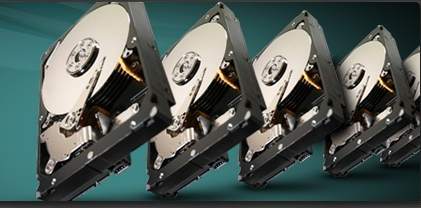Seagate has become the first hard drive manufacturer to achieve the storage density of 1 terabit (1 trillion bits) per square inch.
The new technology is expected to double the storage capacity of current hard drives upon its introduction later this decade, while helping to increase the average HD capacity to a whopping 60 terabytes over the 10 years that follow.

According to Seagate rep Mark Re, the HD manufacturer reached the landmark data density by utilizing heat-assisted magnetic recording (HAMR), a next-gen recording technology.
Current hard drive technology, Perpendicular Magnetic Recording (PMR), is used to record the spectrum of digitized data – from music, photos, and video stored on home desktop and laptop PCs to business information housed in sprawling data centers – on the spinning platters inside every hard drive.
It was first introduced in 2006 to replace longitudinal recording, a method in place since the advent of hard drives for computer storage in 1956, and is expected to reach its capacity limit near 1 terabit per square inch in the next few years.
“The growth of social media, search engines, cloud computing, rich media and other data-hungry applications continues to stoke demand for ever greater storage capacity,” said Re. ”Hard disk drive innovations like HAMR will be a key enabler of the development of even more data-intense applications in the future, extending the ways businesses and consumers worldwide use, manage and store digital content.”
As Re explains, hard drive manufacturers increase areal density and capacity by shrinking a platter’s data bits to pack more within each square inch of disk space. They also tighten the data tracks, the concentric circles on the disk’s surface that anchor the bits. The key to areal density gains is to do both without disruptions to the bits’ magnetization, a phenomenon that can garble data.
Using HAMR technology, Seagate has achieved a linear bit density of about 2 million bits per inch, resulting in a data density of just over 1 trillion bits, or 1 terabit, per square inch – 55 percent higher than today’s areal density ceiling of 620 gigabits per square inch.
The maximum capacity of current 3.5-inch hard drives is 3 terabytes (TB), at about 620 gigabits per square inch, while 2.5-inch drives top out at 750 gigabytes (GB), or approximately 500 gigabits per square inch. However, the first generation of HAMR drives, at just over 1 terabit per square inch, will likely more than double these capacities – to 6TB for 3.5-inch drives and 2TB for 2.5-inch models.
The technology also offers an impressive scale of capacity growth, with theoretical areal density limits ranging from 5 to 10 terabits per square inch – 30TB to 60TB for 3.5-inch drives and 10TB to 20TB for 2.5-inch drives.






